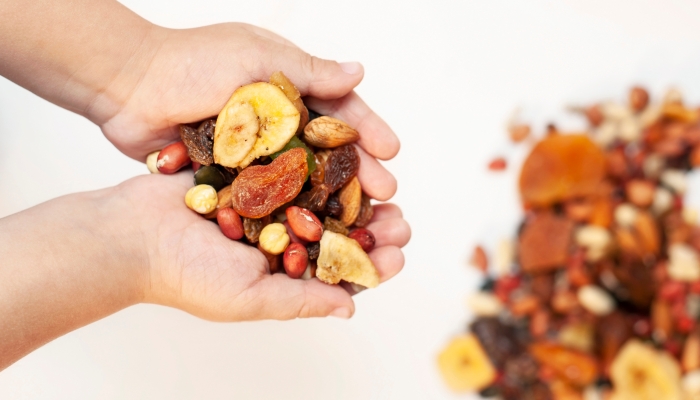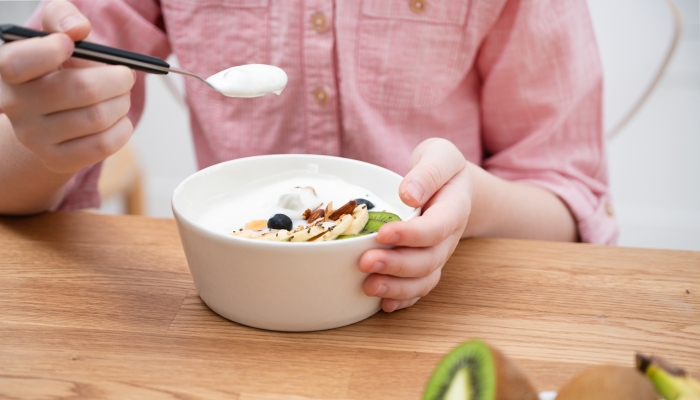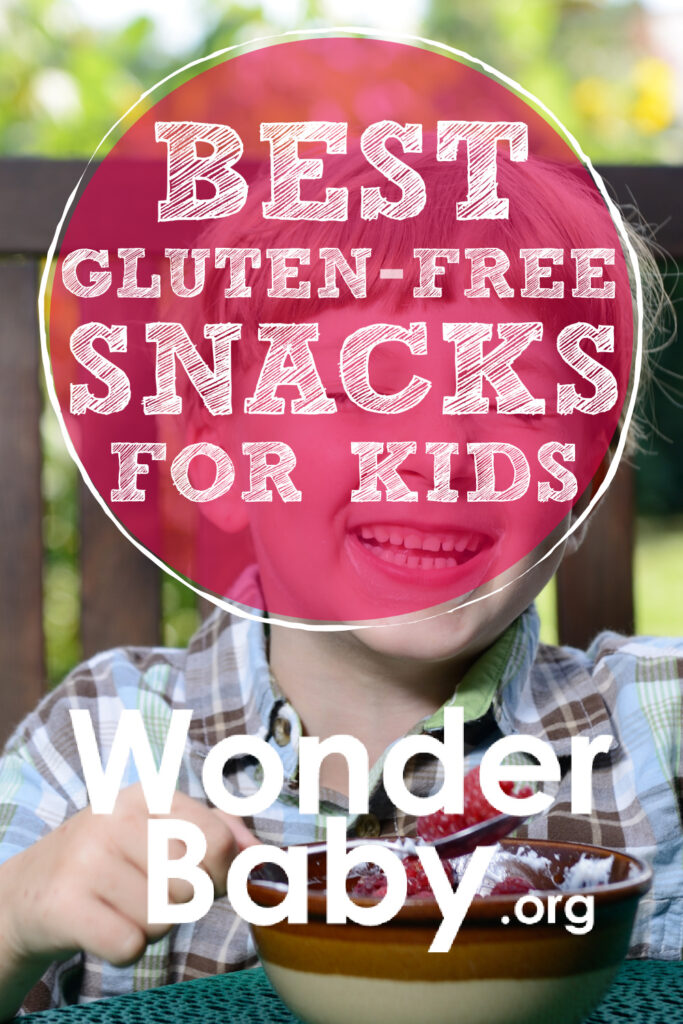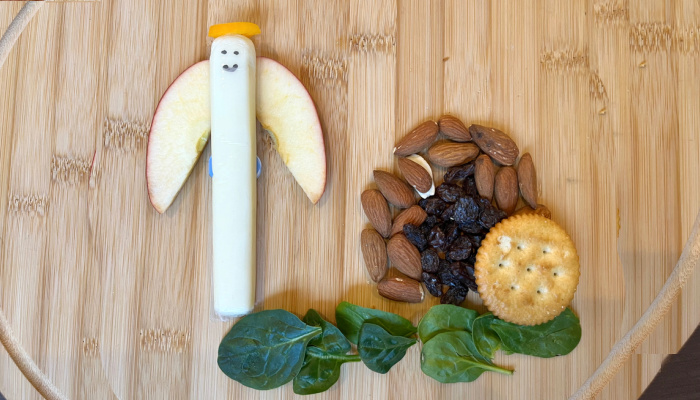13 Best Gluten-Free Snacks for Kids

- There are many tasty snacks that are naturally gluten-free.
- The best snacks for kids contain a balance of vital nutrients, including protein.
- Eating gluten, even in tiny amounts, is unsafe for an individual with celiac disease.
- Check labels on packaged goods carefully for hidden sources of gluten.
- Avoiding snacks and food products high in fat or added sugar is an important part of a healthy lifestyle.
It’s pretty great to be a gluten-free kid these days. Overall, the food industry has embraced the need for gluten-free products and risen to the challenge of providing quality items for consumers of all ages.
Today’s gluten-free market is much different than it was some years ago. Gluten-free foods were primarily sold at health food stores, and the products available in grocery stores were dubious in terms of taste and quality.
Nowhere was this fact more clearly demonstrated than in gluten-free bread—it always had to be toasted in order to hold together, and the feel and taste were nothing like its gluten-filled counterpart.
These days, it’s not hard to find a gluten-free version of your favorite snacks, whether you’re a child or an adult. However, if you’re new to the gluten-free world, you may be wondering how to make a healthy snack that looks and tastes good, while meeting your child’s need for a specialty diet.
If you’re looking for the best gluten-free snacks for your child, read on! We’ve got you covered for a variety of ideas that are sure to tempt even the pickiest eater and help you save a few dollars at the same time.
Our 13 Favorite Gluten-Free Snacks for Kids

When choosing a delicious and nutritious snack, I tend to favor fresh fruit or vegetables paired with some form of protein.
According to a 2019 study by Di Nardo et al titled “Nutritional Deficiencies in Children with Celiac Disease Resulting from a Gluten-Free Diet: A Systematic Review”11. Nardo, G. D., Villa, M. P., Conti, L., Ranucci, G., Pacchiarotti, C., Principessa, L., Raucci, U., & Parisi, P.. Nutritional Deficiencies in Children with Celiac Disease Resulting from a Gluten-Free Diet: A Systematic Review. Nutrients. 2019;11(7), 1588. https://doi.org/10.3390/nu11071588 and published in Nutrients, “Children are, regardless of whether they are on a gluten-free diet or not, at risk of consuming too much fat and insufficient fiber, iron, vitamin D, and calcium.”
Whole foods22. Whole Foods. Whole Foods – NYC Health. https://www.nyc.gov/site/doh/health/health-topics/whole-foods.page#:~:text=Whole%20foods%20are%20foods%20that,of%20developing%20a%20chronic%20disease. like fruit, veggies, and nuts can provide these substances in a way that the body can process well.
The following are kid-approved snack ideas that are also naturally gluten-free:
- Almond butter or other nut butter and apple slices
- Veggies with a savory yogurt-based dipping sauce
- Natural fruit leather and cheese cubes
- Trail mix with sunflower seeds, nuts, or dried fruit
- Fruit cups, packed in 100% juice, with a handful of pumpkin seeds
Reaching for nutritious options at snack time helps fuel your child’s growing body by providing it with the necessary raw materials to help your child grow to their healthy best.
Delicious Carbohydrate-Based Gluten-Free Snacks
Gluten-free doesn’t mean carbohydrate-free. Many different grains and starches, such as potatoes, rice, corn, sweet potatoes, quinoa, and gluten-free oats33. Are Oats and Oat Flour Gluten-Free?. Gluten Intolerance Group. 2023. https://gluten.org/2020/11/20/are-oats-and-oat-flour-gluten-free can be safely enjoyed by gluten-free kids of all ages.
Need to change up your kid-friendly snack routine? Consider the following ideas:
- Mini rice cakes or gluten-free crackers with hummus
- Veggie straws and black bean dip
- Gluten-free pretzels with cheese dip and smoked sausage sticks
- Pumpkin bread made with gluten-free flour and topped with cream cheese.
- Gluten-free crackers spread with peanut butter; make this nut-free by using Wowbutter44. Nutrition Facts. WOWBUTTER. https://wowbutter.com/Nutrition-Facts.htm
One-Bowl Wonders
Looking for an easy treat to make with your child?
Consider these fast and delicious snack ideas:
- Healthy peanut butter cookie bites: Coated in sprinkles, they have a serious “wow” factor—these can easily accommodate a variety of food allergies and are sure to impress your gluten-free kids and their friends
- Chocolate chip energy balls prepared with gluten-free rolled oats
- Chia pudding sweetened with brown sugar, maple syrup, dried fruit, or chocolate chips
- For a decadent treat kids love, try this recipe for pumpkin pie cups; they’re made naturally sweet with maple syrup and feature delicious gluten-free graham crackers! (Bonus—these cups can easily be made dairy-free.)
A stroll down the gluten-free aisle of your favorite grocery store can also yield ideas for the perfect snack that also happens to be allergy-friendly.
The Importance of Gluten-Free Snacks for Kids

Why are gluten-free options important for individuals who can’t tolerate wheat? Perhaps the best way to answer that question is to explore how gluten affects the human body.
What is Celiac Disease?
Celiac disease is an autoimmune condition in which gluten (the protein found in wheat, barley, and rye) attacks the villi (nutrient-absorbing structures) in the small intestine. The presence of healthy villi in the small intestine should look like a thick shag carpet in order to best absorb nutrients from food.
In celiac disease55. Mayo Foundation for Medical Education and Research. Celiac disease. Mayo Clinic. 2023. https://www.mayoclinic.org/diseases-conditions/celiac-disease/symptoms-causes/syc-20352220, gluten damages the villi, which makes them less able to absorb macronutrients (sugars, fats, and proteins) and micronutrients (vitamins and minerals).
When a person with celiac disease eats gluten on a regular basis, the affected small intestine starts to resemble a tile floor—in other words, it has a decreased ability to absorb nutrients from food, which, left untreated, can lead to several vitamin and mineral deficiencies66. Montoro-Huguet, M. A., Belloc, B., & Domínguez-Cajal, M.. Small and Large Intestine (I): Malabsorption of Nutrients. Nutrients. 2021;13(4), 1254. https://doi.org/10.3390/nu13041254.
Gluten Intolerance and Sensitivity
While gluten intolerance and sensitivity are similar to celiac disease in that gluten-containing products are off-limits, they are very different conditions.
Gluten intolerance and sensitivity are also known as non-celiac gluten sensitivity (NCGS). Though individuals with this condition have many of the same symptoms as those with active celiac disease, the main difference is that there is no damage to the villi and nutrient-absorbing capacity in the small intestine.
Celiac Disease and Wheat Allergy
Some celiacs (myself included) will describe their condition as a “wheat allergy.” While not factually accurate, it’s often a short-hand way to help the listener understand that you have a legitimate medical need to be served different food or have your food prepared in a certain way. Often, it isn’t appropriate to launch into a full discussion about what celiac disease is and how it impacts the current situation.
While the symptoms of celiac disease and wheat allergy have some overlap, they are very different conditions with very different biological processes. Here are some of the ways they differ:
| Symptom | Celiac Disease | Wheat Allergy |
| Rash/hives | Not likely | Possible |
| Difficulty breathing | Not likely | Possible |
| Swelling of lips/tongue | Not likely | Possible |
| Vomiting/diarrhea | Likely | Possible |
| Stomach pain | Likely | Possible |
| Weight loss | Likely | Not likely |
| Fatigue | Likely | Not likely |
| Nutrient deficiencies | Likely | Does not occur |
| Headache | Likely | Possible |
| Anaphylaxis | Does not occur | Possible |
The experts at the Allergy and Asthma Network remind us that the main difference between the two conditions is that celiac disease is an autoimmune condition where the body attacks itself, while a food allergy emergency77. Allergy and Anaphylaxis Emergency Plan. American Academy of Pediatrics. 2019. https://downloads.aap.org/HC/AAP_Allergy_and_Anaphylaxis_Emergency_Plan.pdf occurs when a susceptible person encounters food allergens.
Selecting the Best Gluten-Free Snacks

How can you make a healthy food choice for your child when preparing a gluten-free snack?
Consider the following nutritional factors, such as:
Fortification
Many gluten-filled, commercially prepared products like cereals, bread, and pasta are fortified with additional vitamins and minerals to make these products more nutritious.
According to experts at the Mayo Clinic88. Mayo Foundation for Medical Education and Research. Gluten-free diet. Mayo Clinic. 2021. https://www.mayoclinic.org/healthy-lifestyle/nutrition-and-healthy-eating/in-depth/gluten-free-diet/art-20048530, gluten-free foods are often not fortified in the same way as their gluten-containing counterparts and may be less nutritionally dense. Wheat-free products may also have a higher fat and sugar content in order to maintain taste.
Consider talking with your healthcare provider about a multivitamin supplement for your child to help ensure all necessary nutrients are provided to help optimize their growth and development.
Minimally Processed
Foods that are as close to their natural form as possible tend to be sound nutritional choices. Consider fruit, veggies, and gluten-free whole grains like brown rice and buckwheat (Yes, buckwheat isn’t actually a grain—it’s a grass!) as mainstays.
Nutrient Density
In 2014, Drewnowski and Fulgoni III published a study called “Nutrient density: principles and evaluation tools”99. Drewnowski, A., & Fulgoni, V. L.. Nutrient density: principles and evaluation tools. The American Journal of Clinical Nutrition. 2014;99(5), 1223S-1228S. https://doi.org/10.3945/ajcn.113.073395 in The American Journal of Clinical Nutrition that defines nutrient-dense foods as “foods that supply relatively more nutrients than calories.” By using nutrient profiling to rate or classify foods based on their nutritional value, the Nutrient-Rich Foods (NRF) family of nutrient profile models was developed.
The NRF model is significant because it includes nine nutrients to encourage (protein; fiber; vitamins A, C, and E; calcium; iron; potassium; and magnesium) as well as three nutrients to limit (saturated fat, added sugar, and sodium). Higher NRF 9.3 scores are associated with more nutrient-rich diets, giving consumers a way to understand which foods may be best for them.
Examples of low-energy-density and nutrient-rich foods include:
- Spinach
- Eggs
- Avocados
- Blueberries
- Lentils
- Yogurt (plain)
- Quinoa
- Peanut
- Almonds
- Sunflower seeds
Clear Labeling
The best gluten-free snacks also contain clear labeling about the presence of food allergens, as well as if the product was produced on shared equipment with gluten-containing foods.
What to Avoid in Gluten-Free Snacks

When food manufacturers create their products, many different substances may be added to enhance color, flavor, and the ability to be shelf-stable for a period of time. These enhancers are also used in gluten-free items.
In general, it’s best to avoid a gluten-free snack or manufactured food product if it contains:
- Unhealthy additives or preservatives, such as phthalates and nitrates/nitrites1010. Food Additives: What Parents Should Know. HealthyChildren.org. 2021. https://www.healthychildren.org/English/healthy-living/nutrition/Pages/Food-Additives.aspx
- High-fat content (hydrogenated, saturated, or trans fats)
- High sugar content (look for sources like “high fructose corn syrup” or “corn syrup”).
- Ascorbic acid (vitamin C)—used for its antioxidant and stabilizing properties1111. Varvara, M., Bozzo, G., Disanto, C., Pagliarone, C. N., & Celano, G. V.. The use of ascorbic acid as a food additive: technical-legal issues. Italian Journal of Food Safety. 2016;5(1). https://doi.org/10.4081/ijfs.2016.4313
- Cross-contamination with gluten-containing products
The only treatment available for celiac disease at this time is lifelong, complete avoidance of gluten. Always double-check ingredient lists on store-bought snacks and packaged goods to make sure your child’s favorite gluten-free treat can be safely enjoyed.
From energy balls made with gluten-free oats to treats made with gluten-free flour, a wide variety of tasty gluten-free snacks are available. Whether or not your child requires a specialty diet, sound nutritional choices with an abundance of vitamins and minerals position kids to be their healthy best.
References
- Nardo, G. D., Villa, M. P., Conti, L., Ranucci, G., Pacchiarotti, C., Principessa, L., Raucci, U., & Parisi, P. (2019). Nutritional Deficiencies in Children with Celiac Disease Resulting from a Gluten-Free Diet: A Systematic Review. Nutrients, 11(7), 1588. https://doi.org/10.3390/nu11071588
- Whole Foods. Whole Foods – NYC Health. (n.d.). https://www.nyc.gov/site/doh/health/health-topics/whole-foods.page#:~:text=Whole%20foods%20are%20foods%20that,of%20developing%20a%20chronic%20disease.
- Are Oats and Oat Flour Gluten-Free? Gluten Intolerance Group. (2023, October 5). https://gluten.org/2020/11/20/are-oats-and-oat-flour-gluten-free
- Nutrition Facts. WOWBUTTER. (n.d.). https://wowbutter.com/Nutrition-Facts.htm
- Mayo Foundation for Medical Education and Research. (2023, September 12). Celiac disease. Mayo Clinic. https://www.mayoclinic.org/diseases-conditions/celiac-disease/symptoms-causes/syc-20352220
- Montoro-Huguet, M. A., Belloc, B., & Domínguez-Cajal, M. (2021). Small and Large Intestine (I): Malabsorption of Nutrients. Nutrients, 13(4), 1254. https://doi.org/10.3390/nu13041254
- Allergy and Anaphylaxis Emergency Plan. American Academy of Pediatrics. (2019, March). https://downloads.aap.org/HC/AAP_Allergy_and_Anaphylaxis_Emergency_Plan.pdf
- Mayo Foundation for Medical Education and Research. (2021, December 11). Gluten-free diet. Mayo Clinic. https://www.mayoclinic.org/healthy-lifestyle/nutrition-and-healthy-eating/in-depth/gluten-free-diet/art-20048530
- Drewnowski, A., & Fulgoni, V. L. (2014). Nutrient density: principles and evaluation tools. The American Journal of Clinical Nutrition, 99(5), 1223S-1228S. https://doi.org/10.3945/ajcn.113.073395
- Food Additives: What Parents Should Know. HealthyChildren.org. (2021, September 6). https://www.healthychildren.org/English/healthy-living/nutrition/Pages/Food-Additives.aspx
- Varvara, M., Bozzo, G., Disanto, C., Pagliarone, C. N., & Celano, G. V. (2016). The use of ascorbic acid as a food additive: technical-legal issues. Italian Journal of Food Safety, 5(1). https://doi.org/10.4081/ijfs.2016.4313

The information WonderBaby provides is not intended to be, and does not constitute, medical or other health advice or diagnosis and should not be used as such. Always consult with a qualified medical professional about your specific circumstances.
Related Posts

Cooking and Kitchen Play, Tactile Arts and Crafts
9 Best Edible Art Projects for Blind Kids
Crafts can easily be adapted to use edible materials so that tasting is both okay and encouraged.

Cooking and Kitchen Play, Holiday Crafts and Ideas
Easter Resurrection Snack
This Easter Resurrection Snack will delight your little ones. With these healthy ingredients, you can teach your child the true meaning of Easter.

Feeding and Eating, Special Needs
Feeding Therapy Approaches for Infants with Special Needs
Many children with special needs have feeding difficulties. Working with a speech therapist, being patient, and experimenting with textures can help.